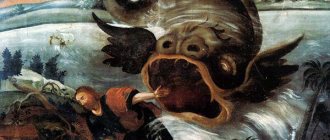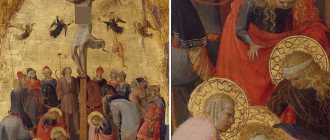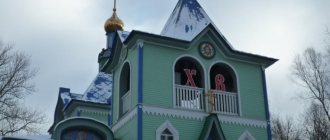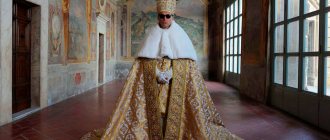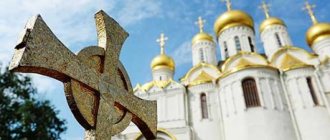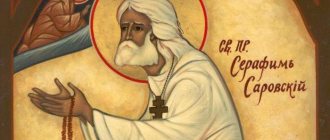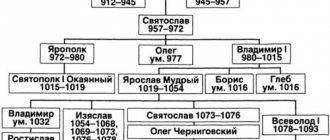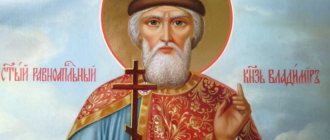Updated: 03/02/2020
Icon painting is a type of artistic art. But, unlike its other types, it carries much more meanings and meanings. The mission of a sacred work is radically different from that of paintings, even if they have spiritual content. Few of the Orthodox icon painters are known; moreover, holy images were often painted collectively: the master painted the face, and the assistants painted everything else. Here are five, perhaps, the most famous icons in the Orthodox world .
Icon of the Vladimir Mother of God
One of the most revered images in Russian Orthodoxy is the Vladimir Icon with the image of the Mother of God. According to legend, it belongs to the brush of the Evangelist Luke. The image, as the same legend says, was painted on a wooden tabletop where the Savior, the Most Pure Virgin and the righteous Joseph gathered for a meal.
The image came to Russia in 1131 - it was sent as a gift to Yuri Dolgoruky. Since then, he has been protecting Rus' from foreigners and performing miracles. Thus, they say that the icon saved the Russian land from Tamerlane, in 1480 - from the destruction of Rus' by the Golden Horde leader Akhmat, and in 1521 it saved Moscow from the defeat of the Kazan Khan Mehmet-Girey.
"Blessed Star" Mother of God
The creation of Alexander Kazantsev, which was published around 1690. The icon painter was inspired by scenes from the literary collection “The Most Bright Star,” which had 15 chapters, scenes from which are depicted on the icon.
The Mother of God is depicted in full growth, she has long brown hair that flows freely to her shoulders. She is wearing a bright robe with an ornament, and a crown adorns her head. The Child Christ hugs his mother with one hand and holds a Catholic rosary with the other.
"Trinity" by Andrei Rublev
In the Tretyakov Hall there is one of the most famous icons of the Orthodox world - “The Trinity”, painted by Andrei Rublev - the master’s most famous work. It was created at the beginning of the 15th century (experts find it difficult to name the exact date) for the majestic white stone Trinity Cathedral.
It was assumed that the icon would stand to the right of the Royal Doors. The image is multifaceted and multi-layered, filled with symbols and meanings. Therefore, a lot of scientific research has been devoted to the plot of this masterpiece.
Our Lady of All Who Sorrow, Joy of All Who Sorrow
This miraculous icon was miraculously found in the village of Klotsky near St. Petersburg. She was in a small church. At the beginning of the 19th century, lightning struck the church and burned it down. The icon miraculously managed to survive. Then, incredibly, coins from the benefactors' casket got stuck in the icon. The icon began to work miracles. Patriarch Joachim had a sister.
In 1688, she prayed for salvation from a long incurable illness that tormented her. Suddenly she heard a voice telling her to go to the Temple of the Metamorphosis of the Son of God. There she was supposed to find an icon called “The Joy of All Who Sorrow.” The voice told her that after this Euphemia would get better. The young woman did just that. The miracle of healing occurred on October 24, 1688 according to the Orthodox calendar. Now this day is considered an Orthodox holiday.
Icon of the Kazan Mother of God
The miraculous canonical icon was found in the mid-summer of 1579, a quarter of a century after the conquest of the Kazan Khanate by Ivan the Terrible. Patriarch Hermogenes wrote that on the eve of July 8 - the day the relic was found - a strong fire occurred in Kazan, due to which half the city burned out, including part of the Kremlin. The Tatars gloated - they say that higher powers punished the wicked who encroached on Muslim lands. Sagittarius Daniil Onuchin was going to build a new house on the site of the burnt one, but his ten-year-old daughter Matrona prevented him.
The girl said that the Mother of God appeared to her in a dream and ordered her to find an image at the site of the future construction site. They waved the little girl aside, but she insisted again and again that the fire needed to be dug up.
In the end, they gave in to the girl and began to rake away the ashes and remains of the burnt building. This is how the image of the Kazan Mother of God was found on the ashes. The miraculous icon cured diseases and inspired soldiers; Peter I and Mikhail Kutuzov prayed before it on the eve of great campaigns. At the beginning of the last century, the icon was destroyed, but numerous copies of it were distributed throughout the world. The earliest one can be seen in the hall of the Tretyakov Gallery.
Creator of the Belly
A very rare icon. “Creator of the Belly” means “Creator of Life and all living things.” In this icon Jesus is holding a human fetus.
This is a relatively modern image that reminds us that any life on earth arises only by the Will of God. This image protects doctors and nurses, and also helps babies appear on earth.
“Savior Not Made by Hands” by Simon Ushakov
Perhaps the most interesting ancient icon is “The Savior Not Made by Hands”, painted in 1658 in the workshop of Simon Ushakov, a royal icon painter of the 17th century. It is interesting for its non-canonical nature and realism - before this, images were written according to the strictest rules. The face of the Savior on the ubrus looks humane and benevolent, even the eyelashes are carefully painted - this is uncharacteristic of ancient Russian icon painting.
The subject of the icon was a biblical legend. One day the Savior washed his face, dried himself with a towel, and his image remained on the cloth. This became the first image of Jesus. The miraculous face is one of the most sacred and revered in Christianity. And it was precisely this that Simon Ushakov repeatedly reproduced in his creations. The most famous piece of furniture by Ushakov is today carefully preserved in the Tretyakov Gallery.
Painting of the North “Northern letters”
The most interesting and numerous group of icons in the Hermitage represents painting from the Russian North. And this is no coincidence. Museum expeditions to collect ancient monuments worked in the 50-60s mainly in the northern outskirts of the European part of the USSR. They visited the banks of the Northern Dvina, Onega, and the White Sea, in Karelia, on the Kola Peninsula, and examined many churches of the 18th and 19th centuries, which, as a rule, were built on the sites of older churches, and therefore early monuments of art were discovered here.
They developed under the influence and/or direct influence of the traditions of large art centers and have features of local originality. the earliest of these date from the 14th century. They come from the Vazentsy churchyard, located in that part of the Onega River that was inhabited by Novgorodians from ancient times. All four icons are perceived as part of a single whole: of the same height, oblong, roughly chopped, with half-length images of saints. They were apparently in the rectal (frontal) Deesis order and were painted by the same master. The wider one with the image of Christ was located in the center. Adjacent to it were “Apostle Peter”, “Nicholas”, “Ilya”. The faces of the saints with the characteristic sharp, angular outline of the eyes and nose are executed confidently and energetically. Bright cinnabar on the lips. There are many ornaments: in clothes, a halo, attributes, near inscriptions. The texts are written in an ancient manner: double-circuit letters reminiscent of ancient manuscripts.
Lyadina icons. “The Miracle of George about the Serpent”
A large group of ancient Russian icons was discovered in the Lyadina churchyard (Kargopolye). The similarity between them is so great that we can confidently talk about one workshop and even one master. Thus, the painter who created the laconic composition “The Miracle of George on the Dragon” on a remote double-sided icon of the 16th century repeats it on another icon board, but on a larger scale.
Miracle of George about the serpent. Northern letters. 17th century
“The Fiery Ascension of the Prophet Elijah”
Northern icon painters sometimes handled iconography quite freely, conveying traditional subjects and images in their own way. They introduced completely independent figures of saints into the main scenes and combined images of different content. The composition “The Fiery Ascent of the Prophet Elijah” from the early 17th century unexpectedly included the image of Nikola. The artist painted two saints at once, especially revered by the people - Elijah, who protected from bad weather, and Nicholas the Wonderworker, a healer.
Fiery Ascension of Elijah the Prophet. 17th century
“Flor and Laurus on horseback”
This is an unusual icon from the same time. The type of holy horse breeders is similar to the canonical image of the holy princes Boris and Gleb on horses.
Florus and Laurel on horseback. 17th century
Peculiarity of Northern icon painting: connection with applied art
This is typical for northern icons. And this feature manifests itself, for example, in filling the icon fields with frames with ornaments. In the icon from the Kirillo-Belozersky Monastery, the ornamentation imitates a rich silver and niello frame. It presents an expressive image of “John the Theologian in silence” with an angel personifying the “holy spirit”, a symbol of wisdom. The inscription on the back says that the icon was painted by the “much-sinful monk Nektariy Kulyuskin” in 1679.
John the Evangelist in silence. 1679
The icon “Elijah in the Desert” from the Onega River is especially decorative. The rural painter filled the free space around the prophet with fantastic hills and trees in the form of black bushes with white and red spots.
Elijah the Prophet in the desert. Early 16th century
“Apostles Peter and Paul”
This masterpiece of ancient Russian painting was taken from the village of Mondina on Onega. From the lengthy inscription on its back side, you can find out that the work was created in 1708 by a master resident of the village of Mudyug, Feoktist Klimentov, and the customers were local residents: Mudyug resident Lazar Irodionov and Mondino resident Bogdan Prokopyevich Dyatlev. The soil and the background of the icon are interestingly designed. On the soil there are carefully painted bushes of stylized flowers with long intertwining leaves, similar to the headpieces of Pomeranian manuscripts of the early 18th century. The clear graphic ornament of the lower part of the icon contrasts with the picturesque background of bushes made with a free stroke.
Apostles Peter and Paul.1708
Laconism and archaic icons of the North
Each school of ancient Russian icon painting had its own characteristics. Many northern icons are extremely laconic and archaic. Such is the elegant “Descent into Hell” with heavy, frozen, rough forms from the Church of the Resurrection in the village of Vashina, Leningrad Region, and from the same place “The Fiery Ascension of the Prophet Elijah”, which attracts with its naive, brightly colored design.
Descent into Hell, with holidays and scenes of the Passion in 24 hallmarks. 1630
“Zosima and Savvaty the Solovetsky Wonderworkers” is distinguished by its direct interpretation of the plot with few characters and lengthy inscriptions. The saints are depicted full-length near the monastery. Around them are 14 hagiographical marks. All three works are late, from the end of the 17th-18th centuries, but they do not seem alien among the earlier “northern letters”, since in the remote outskirts of Ancient Rus' the old traditions were preserved for a particularly long time.
“Savior in Power” by Rublev
The icon “Savior in Power” by the famous Andrei Rublev is very symbolic. According to the creator's plan, it represents the image of Christ located at the center of the Universe. In fact, this is a visual diagram of the Christian world order with all its attributes.
The “Savior in Power” icon is the most important relic in Orthodoxy, and therefore it is always placed in the center of the temple iconostasis, above the Royal Doors. The image by Andrei Rublev is today in the Tretyakov Gallery, in a glass sarcophagus, where special conditions have been created for its storage.
Dormition of Our Lady
Novgorod craftsmen created the icon “The Dormition of the Mother of God” for the Church of the Nativity of the Virgin Mary, which was located in the Desyatinny Monastery. In 998 it was founded by the first Novgorod bishop Joachim.
In addition to the deceased Mother of God on the bed and Christ with her soul in his arms, here is a plot about the journey of the apostles to the house of John the Theologian, where Mary was dying. According to the legends of the New Testament, the apostles at that moment were in different countries where they preached the teachings of Christ. So that they had time to say goodbye to the Mother of God, angels miraculously carried them on clouds to her bed.
The icon painter used tempera for this work, a paint based on natural powder pigment and egg emulsion. It was applied to a specially prepared wooden base. The master relied on the traditions of Byzantine art of the 11th–12th centuries, as evidenced by the large size - 155x128 centimeters, symmetrical composition and a lot of free space in the background.
